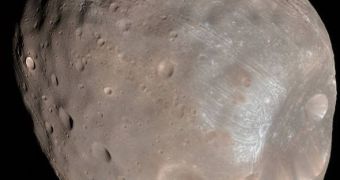While the Red Planet has gotten a lot of attention from both space agencies and the general public over the past few decades, Mars' moons, Phobos and Deimos, have experienced a lot less of it. A few fly-by flights and some telescope observations make up all the science associated with them. But now, an international effort made up of experts from Canada, Russia and the US is looking at fixing that, by planning a space mission to the Phobos moon alone, for research purposes.
Most astronomers in the international community cannot even agree if the two celestial bodies orbiting the Red Planet are moons, satellites, asteroids that somehow got trapped by Mars' gravity, or maybe even pieces of the planet, blasted off by a comet impact in very much the same way our Moon was formed. Still, because of the importance that their neighbor has, the two moons have gotten little attention over the years. The only country in the world that has been constantly trying to get a spacecraft to Phobos is Russia, but all its efforts, spanning many years, have failed to reach their target, Space reports.
The Russians have a great deal of experience in working with unmanned sample-recovery missions. On our own Moon, they sent a myriad of robotic vehicles between 1959 and 1976, with the sole purpose of landing, collecting samples, and then sending them back home aboard a small spacecraft sitting atop the lander. Erik Galimov, the director of the Institute of Geochemistry and Analytical Chemistry in Moscow, Russia (the institution that houses all lunar samples brought back by Russian missions), says that analyzing soil samples from Phobos or Deimos could yield more insight into how the two bodies formed, and where they came from.
Objectively speaking, it's a lot easier to get to a Martian moon than to the planet itself, mainly because the small rocks have no atmosphere, and a very weak gravitational pull. This means that a lander needs to be less intricate than, say, the Phoenix Mars Lander, with all its heat shields and parachutes to protect it from atmospheric reentry. Still, the minimal cost for a mission to Phobos was calculated at about 72 million US dollars, or 2.4 billion rubles. In addition, costs are driven up by the fact that more and more instruments are being added to the plan. The total count is now up to 11, as opposed to the three or four NASA probes usually carry.

 14 DAY TRIAL //
14 DAY TRIAL //